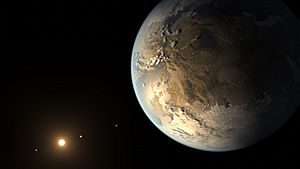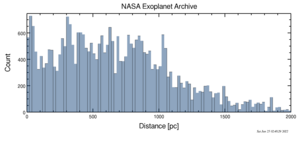Lists of planets facts for kids
A planet is a huge, round space object. It's not a star, and it's not what's left after a star dies. Scientists think planets form from giant clouds of gas and dust in space. These clouds slowly pull together to make a young star, with a spinning disk of material around it. This disk then forms planets.
We have eight planets in our Solar System. Planets found outside our Solar System are called exoplanets.

Many exoplanets were found by the Kepler space telescope. There are also thousands more possible exoplanets that still need to be officially confirmed. These were found by Kepler and another mission called the Transiting Exoplanet Survey Satellite (TESS).
- Transit: 4,171 (74.3%)
- Radial velocity: 1,089 (19.4%)
- Microlensing: 214 (3.8%)
- Direct imaging: 69 (1.2%)
- Transit-timing variation: 29 (0.5%)
- Eclipse timing variation: 17 (0.3%)
- Orbital brightness modulation: 9 (0.2%)
- Pulsar timing variation: 8 (0.1%)
- Astrometry: 3 (0.1%)
- Pulsation timing variation: 2 (0.0%)
- Disk kinematics: 1 (0.0%)
Contents
Planets in Our Solar System
Our Solar System has eight main planets. These are Mercury, Venus, Earth, Mars, Jupiter, Saturn, Uranus, and Neptune.
- For a list of objects in our Solar System that are round because of their own gravity, see: List of gravitationally rounded objects of the Solar System. This list includes the eight planets.
- Some objects were once called planets but aren't anymore, like Pluto. You can find them here: List of former planets.
- There are also some planets that scientists thought might exist in our Solar System but haven't been proven. See: List of hypothetical Solar System objects.
Planets Outside Our Solar System (Exoplanets)
Exoplanets are planets that orbit stars other than our Sun. They are found in other star systems. Scientists use different ways to find them.
- Directly Imaged Exoplanets: These are exoplanets that scientists have actually taken pictures of. See: List of directly imaged exoplanets.
- Extreme Exoplanets: Some exoplanets are super hot, super cold, or super small. See: List of exoplanet extremes.
- First Discoveries: Learn about the very first exoplanets ever found. See: List of exoplanet firsts.
- Kepler Mission Discoveries: The Kepler space telescope found many exoplanets. See: List of exoplanets discovered by the Kepler space telescope and List of exoplanets observed during Kepler's K2 mission.
- Water Worlds: Some exoplanets might have liquid water, which is important for life. See: List of extrasolar candidates for liquid water.
- Multiplanetary Systems: These are star systems that have more than one exoplanet orbiting their star. See: List of multiplanetary systems.
- Nearest Exoplanets: Find out which exoplanets are closest to Earth. See: List of nearest exoplanets.
- Potentially Habitable Exoplanets: These are exoplanets that might have the right conditions for life to exist. See: List of potentially habitable exoplanets.
- Smallest Exoplanets: Discover the tiniest exoplanets found so far. See: List of smallest exoplanets.
How Exoplanets Are Found
Scientists use several clever ways to find exoplanets, even though they are very far away.
- Radial Velocity: This method looks for tiny wobbles in a star's movement. A planet's gravity can make its star wobble. See: List of exoplanets detected by radial velocity.
- Transiting Exoplanets: This is when a planet passes in front of its star, causing the star's light to dim slightly. See: List of transiting exoplanets.
- Microlensing: This method uses the gravity of a planet and its star to bend light from a background star, making it appear brighter for a short time. See: List of exoplanets detected by microlensing.
- Direct Imaging: Sometimes, powerful telescopes can take a direct picture of an exoplanet. See: List of directly imaged exoplanets.
Other Types of Planets
- Fictional Planets: Many books, movies, and games feature made-up planets. See: Planets in science fiction and Fictional planets of the Solar System.
- Planets in Astrology: In astrology, planets have different meanings and influences, which is different from how scientists define them. See: Planets in astrology.
See also
- Lists of astronomical objects
- Definition of planet
- List of exoplanet search projects



